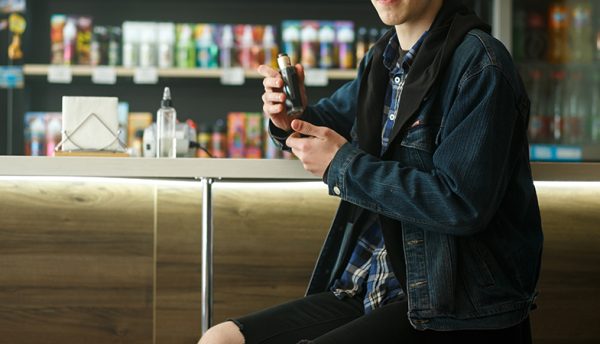Vaping has seen a massive surge in popularity in many countries over the past few years, with teenage use accelerating, shops selling vapes illegally without conducting appropriate and effective age checks is a contributing factor. We speak to Andrew O’Brien, Biometrics Product Manager at Innovative Technology (ITL), a cash handling equipment manufacturer utilising AI powered biometrics to deploy accurate age checks, display targeted advertisements and collate customer demographics. O’Brien tell us how biometric technology can support retailers with the necessary tools to help stem and reverse this disturbing trend.

E-cigarettes and vaping: a definition
An e-cigarette is a device that allows you to inhale nicotine in a vapour rather than smoke. They do not burn tobacco or produce tar or carbon monoxide and work by heating a liquid (called an e-liquid) that contains nicotine. Using an e-cigarette is known as vaping, hence the popular name given to e-cigarettes is ‘vapes’.
Vapes were devised as an aid to stop smoking. However, they are becoming increasingly popular among teenagers who are neither former or current smokers, in particular the disposable, single use, pre-filled vapes that are cheap, compact and require no set up. As a young person’s brain does not fully develop until age 25, it is imperative that as a society we have the right laws and regulations in place to help avoid unpreventable addiction and adverse effects that nicotine-based products can have. Ensuring age verification technology is readily available to retailers to make the age check process simple and effective will help restrict teen access to vapes.
Usage and the law
In the UK, like many European countries, the legal age to purchase and use an e-cigarette is 18 years. The penalty for selling either cigarettes or e-cigarettes with nicotine containing vape juices to someone underage is currently a £2,500 fine.
In a recent Serve Legal survey (UK’s leading age verification audit and age verification testing company), a massive 42% of respondents had tried a vape before turning 18. And latest figures from Action on Smoking and Health (ASH) reveal that vaping rates among 11–17 year-olds have risen from four percent in 2020 to seven percent in 2022. Yet more worryingly, for the lower 11–15 year-old age group in England this figure is even higher with the latest data reporting usage of e-cigarettes rising to nine percent. Specifically, vaping among 15-year-old girls has jumped significantly from 10% in 2018 to 21% in 2021.
Where are teenagers purchasing e-cigarettes?
It is important to understand where vapes are being purchased in order to stop this rapid increase in use amongst teens. In the Legal Serve survey, 70% of respondents purchased their vapes from corner shops and convenience stores. Consequently, we need to help retailers manage this problem by giving them the means to perform accurate age checks on customers trying to purchase vapes to identify those who are underage.
Inconsistent ID checks
Since January 2021, Serve Legal have conducted over 22,000 e-cigarette purchase tests, both instore and online. Their data showed that one in four auditors being sold e-cigarettes without being asked for age verification or identification.
Serve Legal reported: “When looking at 2022 data, it is clear that supermarket retailers compliance with vaping, is falling lower than tobacco and cigarette compliance.”
Challenge 21 and Challenge 25 are part of a scheme in the United Kingdom to prevent young people gaining access to age restricted products such as vapes. Under the scheme, retailers should ask any customers attempting to buy age-restricted products to prove their age if they look under 21 or 25, even though the minimum age in the UK is 18. Legal action can be taken on any retailer who does not follow this scheme and the number of reported cases and fines are on the increase.
Biometric technology can help retailers by giving them an extra level of assurance during the age check process to prevent fines being given.
How can biometric technology ensure compliance?
Using biometric technology for age checks works by analysing the customer’s facial features to predict their age. This can automate the age check process and offer servers an added layer of security and confidence when selling restricted products.
Appearance isn’t always a clear indication of a customer’s age, and human estimations are subjective – especially when a server is less experienced or unfamiliar with the task. Even when implementing Challenge 21 and Challenge 25, your staff could vastly misinterpret someone’s age without even knowing it.
With biometric technology, however, you can rely on heavily tested algorithms that have a proven track record of accuracy which all our AI-powered age check solutions feature. Both MyCheckr and ICU Lite have been independently tested by the Age Check Certification Scheme (ACCS) to determine the discrepancy between estimations and the real ages of a control group, resulting in an average underestimation of just 0.19 years. Therefore, the use of a biometric solution can significantly reduce your risk of selling to underage customers. As well as ensuring vapes and other age-restricted goods are not sold to those who are underage, our solutions can help reduce potential confrontation towards staff that can often arise when challenging customers for ID.
MyCheckr is a stand-alone solution ideal for retailers selling age restricted goods such as vapes. Already being utilised in a number of convenience stores it is equipped with a camera and a screen that predicts a customer’s age quickly and completely anonymously. For a solution that can work with existing POS systems or even vending machines, ICU Lite, a compact plug-in device, can completely automate the age check process.
Being one of the first biometric age estimation devices to receive GDPR accreditation, it means that by using our solutions there is no need for retailers to worry about data privacy as no images are stored on our devices. Plus, its affordable for even the smallest retail outlet, available at a one-off cost, with no charges per individual age check.
Major issue in secondary schools
In a recent OPSS (Office for Product Safety and Standards) Expert panel on Age Restrictions, Mr Glyn Potts, Headteacher at Newman RC College in Oldham spoke about the challenges of vaping among the children attending his high school.
Glyn said: “What we need, is far greater legislation alongside more evidence of the harmful impact of such devices. This is not an issue for schools, but an issue for society and if not tackled could become the big new tobacco issue.”
It is a major issue in Scotland where charity Young Scot are working with ASH Scotland on an e-cigarette’s information campaign following a national survey of young people which found very high levels of e-cigarette use within Secondary Schools. The ASH Scotland survey found that one in 10 pupils now regularly vape and e-cigarettes used by 15-year olds had tripled in the last five years.
Industry-wide collaboration
Research suggests that vape-use amongst teens is only going to increase if action is not taken now.
Parents, Government and authorities must educate children on the risks. There needs to be more control on packaging and marketing strategies – current colours, flavours and names are clearly attractive to children. Vapes need to be displayed in a more responsible way near the cigarettes rather than at tills where sweets and chocolate are. Underage TikTok users being gifted vapes (rather than selling them which would be deemed illegal) to try and market to their followers is another loophole that needs to be closed.
All these things will take time to come to fruition but one thing that is available to help now is biometric technology. Retailers can utilise this technology to assist with age checks to prevent vapes being sold to minors and the resultant fines.
Images
AdobeStock_288048772_Editorial_Use_Only
AdobeStock_268342000
AdobeStock_492862191
Click below to share this article

